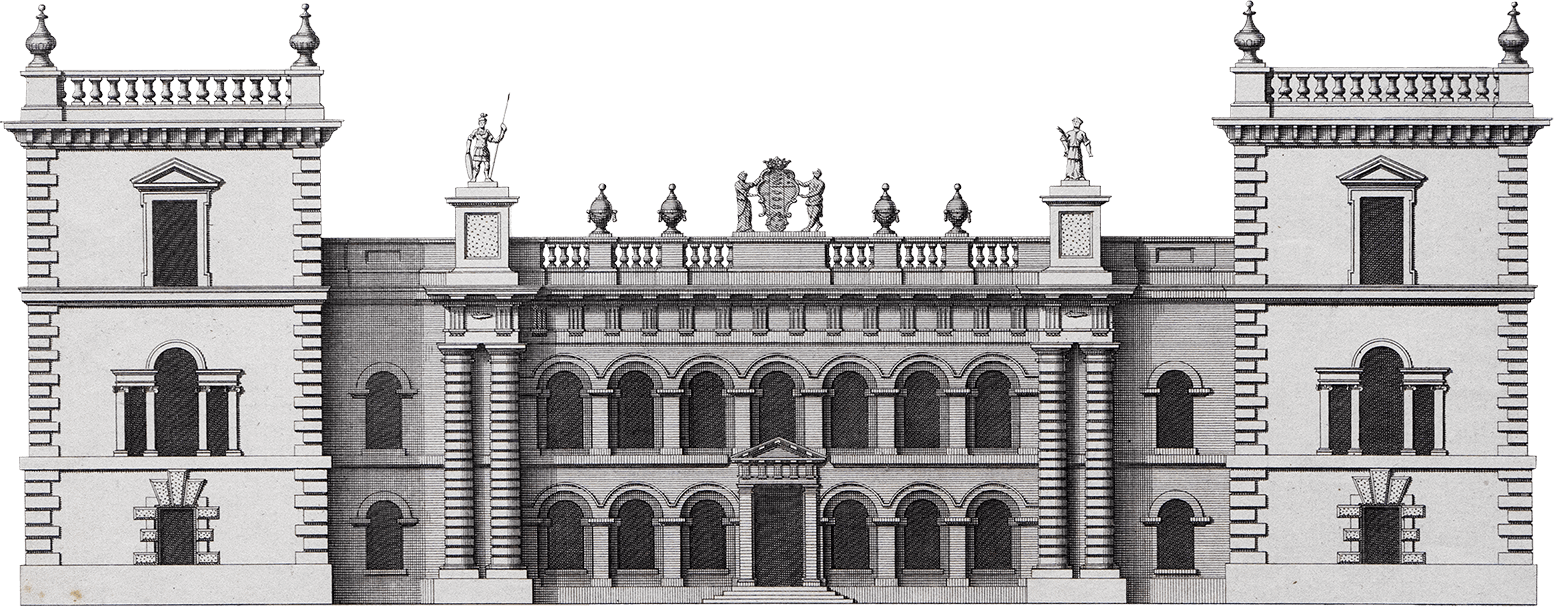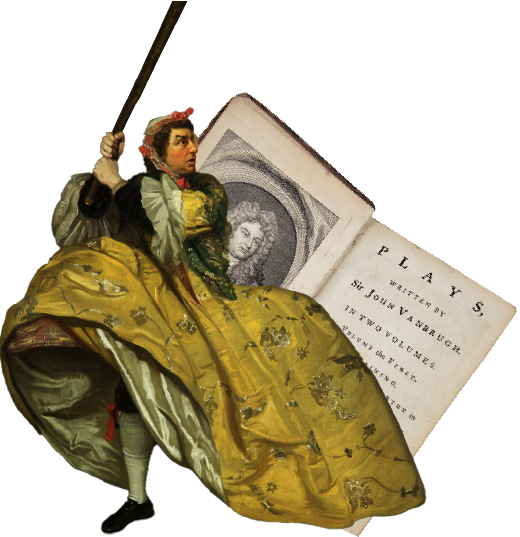Biography and Architecture
Gilbert Lovegrove, The Life, Work, and Influence of Sir John Vanbrugh (London, 1902).
Christian Barman, Sir John Vanbrugh (London: Ernest Benn, 1924)
H. Avray Tipping and Christopher Hussey, The Work of John Vanbrugh and School 1699– 1736 (London: Country Life, 1928)
Geoffrey Webb, Vanbrugh’s Complete Works (London: Nonesuch Press, 1928)
Laurence Whistler, Sir John Vanbrugh: Architect & Dramatist 1664–1726 (London: Cobden-Sanderson, 1938)
Laurence Whistler, The Imagination of Vanbrugh and His Fellow Artists (London: Art and Technics, 1954)
David Green, Blenheim Palace (London: Country Life, 1951)
Kerry Downes, Sir John Vanbrugh: A Biography (London: Sidgwick & Jackson, 1987),
Kerry Downes, ‘Vanbrugh over Fifty Years’ in Christopher Ridgway and Robert Williams (eds.), Sir John Vanbrugh and Landscape Architecture in Baroque England 1690–1730 (Stroud: Sutton Publishing, 2000),
Geoffrey Beard, The Work of John Vanbrugh (London: B.T. Batsford, 1986)
Giles Worsley, In Search of the English Baroque: English Architecture in a European Context 1660–1725 with a chapter on ‘Vanbrugh and the Search for an English Architecture’ based on ‘Sir John Vanbrugh and the Search for a National Style’ in Michael Hall (ed.), Gothic Architecture and its Meanings 1550–1830 (Reading: Spire Books, 2002)
Vaughan Hart, Sir John Vanbrugh: Storyteller in Stone (New Haven: Yale University Press, 2008),
Jeremy Musson, The Country Houses of Sir John Vanbrugh (London: Aurum, 2008)
Gavin Stamp, ‘Shakespeare in Stone’, first published in Apollo, January 2009 and republished in Anti-Ugly: Excursions in English Architecture and Design (London: Aurum, 2013)
Anthony Geraghty, ‘Castle Howard and the Interpretation of English Baroque Architecture’ in M. Hallett et al. (eds.), Court, Country, City: Essays on British Art and Architecture, 1660– 1735, Studies in British Art, 24 (New Haven: Yale University Press, 2016), pp 127–149.
Anthony Geraghty, Wren, Vanbrugh, Hawksmoor: Three Baroque Architects, Three Baroque Buildings (forthcoming)
James Legard, 'Queen Anne, Court Culture and the Construction of Blenheim Palace’ (Journal for Eighteenth-Century Studies, 37:2, 2014, pp 185-197)
Charles Saumarez Smith, John Vanbrugh: The Drama of Architecture (London: Lund Humphries, 2025)
Rory Fraser, Castles in the Air: John Vanbrugh and the Birth of Britain (London: William Collins, 2026)
Theatre
Bonamy Dobrée, Essays in Biography 1680–1725 (Oxford: Oxford University Press, 1925)
Madeleine Bingham, Masks and Façades: Sir John Vanbrugh, The Man in his Setting (London: George Allen & Unwin, 1974)
Judith Milhous, ‘New Light on Vanbrugh’s Haymarket Theatre Project’ (Theatre Studies, 17, 1976, pp 143–161)
Judith Milhous, Thomas Betterton and the Management of Lincoln’s Inn Fields, 1695– 1708 (Carbondale: Southern Illinois University Press, 1979)
Curtis Price, ‘The Critical Decade for English Music Drama, 1700–1710’ (Harvard Library Bulletin, 26, 1978, pp 38–76).
Graham F. Barlow, ‘Vanbrugh’s Queen’s Theatre in the Haymarket, 1703–9’ (Early Music, 17:4, 1989, pp 515– 21).
Frank McCormick, Sir John Vanbrugh: The Playwright as Architect (University Park, Pennsylvania: Pennsylvania State University Press, 1991)
Frank McCormick, Sir John Vanbrugh: A reference guide (New York: G.K. Hall & Co., 1992).
Abigail Williams, Poetry and the Creation of a Whig Literary Culture 1688–1715 (Oxford: Oxford University Press, 2005)
Joseph Hone, Literature and Party Politics at the Accession of Queen Anne (Oxford: Oxford University Press, 2017)
R.O. Bucholz, The Augustan Court: Queen Anne and the Decline of Court Culture (Stanford, CA: Stanford University Press, 1993)
James A. Winn, Queen Anne: Patroness of the Arts (Oxford: Oxford University Press, 2014)
Gardens
Christopher Ridgway and Robert Williams, Sir John Vanbrugh and Landscape Architecture in Baroque England 1690–1730 (Stroud: Sutton, 2000)
Tim Richardson, The Arcadian Friends: Inventing the English Landscape Garden (London: Bantam Books, 2007)
Caroline Dalton, Sir John Vanbrugh and the Vitruvian Landscape (Abingdon: Routledge, 2012)
David Jacques, Gardens of Court and Country: English Design 1630–1730 (New Haven: Yale University Press, 2016)
Tim Richardson, The English Landscape Garden: Dreaming of Arcadia (London: Frances Lincoln, 2024)
General Reading
David Green, Sarah Duchess of Marlborough (London: Collins, 1967)
Frances Harris, A Passion for Government: The Life of Sarah, Duchess of Marlborough (Oxford: Clarendon Press, 1991)
Ophelia Field, The Favourite: Sarah, Duchess of Marlborough (London: Hodder & Stoughton, 2002)
Ophelia Field, The Kit-Cat Club: Friends Who Imagined a Nation (London: Harper, 2008)
Frances Harris, The General in Winter: The Marlborough-Godolphin Friendship and the Reign of Queen Anne (Oxford: Oxford University Press, 2017)
Tim Harris, Revolution: The Great Crisis of the British Monarchy, 1685–1720 (London: Allen Lane, 2006)
Ruth Paley and Paul Seaward (eds.), Honour, Interest and Power: An Illustrated History of the House of Lords, 1660–1715 (Woodbridge: Boydell Press, 2010)
Helen Jacobsen, Luxury and Power: The Material World of the Stuart Diplomat, 1660–1714 (Oxford: Oxford University Press, 2012)
Julian Hoppit, A Land of Liberty? England 1689–1727 (Oxford: Oxford University Press, 2000)
 Back to homepage
Back to homepage





